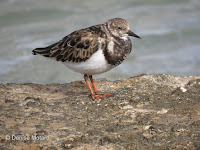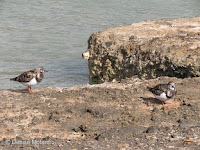RUDDY TURNSTONE
RUDDY TURNSTONE (Arenaria interpres) – (See images below)
DESCRIPTION: The Ruddy turnstone is a shorebird in the Sandpiper family. In breeding plumage the top parts are mottled reddish brown. The reddish color disappears in the non-breeding plumage. The head is white with black stripes on the cap. The breast is black and forms two curves. The under parts are white. The bill is dark grey and the eyes are black. The legs and feet are orange. To help them keep balance on slippery rocks, they have short legs, small spines on their feet and curved toenails. Sexes are similar, but females have duller colors. The juvenile looks very different, Ruddy turnstones are about 9 inches (22 cm) long.
VOICE: https://www.xeno-canto.org/species/Arenaria-interpres
NAME: The English name ‘Turnstone’ refers to the feeding behavior of this bird, literally turning over stones to find invertebrates under them. The name ‘ruddy’ refers to the color of the bird’s breast. The Latin species name ‘Arenaria’ refers to sand (arena) for the bird’s habitat. As for ‘interpres’, the species name, it means ‘tell-tale’ in this context, because the ruddy turnstone alerts other shorebirds of the presence of predators with its calls.
HABITAT: During breeding season: tundra coastlines; elsewhere, prefers rocky beaches or human-made structures such as sea walls or jetties.
DIET: Omnivorous and opportunistic – insects, berries, crustaceans, molluscs, eggs from other bird species, even carrion and human food waste.
NESTING: The nest is a shallow depression on the ground and may be located on rocks or vegetation. An average of four light green eggs are laid. Chicks can feed themselves but are protected by their parents.
DISTRIBUTION: Ruddy turnstones breed in the Arctic around the world. They are long distance migrants and fly as far south as New Zealand (see reference below).
Distribution map: https://en.wikipedia.org/wiki/Ruddy_turnstone#/media/File:Arenaria_interpres_map.svg
ON PEI: The ruddy turnstone is fairly common on Prince Edward Island beaches in the fall, during its migration south.
ON HAWAII: This species spends the winter on all Hawaiian Islands, which means they arrive in late August. It is seen in flocks along shorelines but also on lawns and in fields. Some individuals will also spend the summer in Hawaii, although they won’t breed.
CONSERVATION: The population of the ruddy turnstone appears stable and is sufficiently large and widespread to be of ‘least concern’.
SIMILAR SPECIES: Black Turnstone
REFERENCES: https://en.wikipedia.org/wiki/Ruddy_turnstone
https://abcbirds.org/bird/ruddy-turnstone/
https://www.allaboutbirds.org/guide/Ruddy_Turnstone/overview
http://birdweb.org/birdweb/bird/ruddy_turnstone
https://www.thespruce.com/ruddy-turnstone-3884277
http://www.arkive.org/ruddy-turnstone/arenaria-interpres/
http://www.nzbirdsonline.org.nz/species/ruddy-
turnstone
http://www.nhptv.org/natureworks/ruddyturnstone.htm (New Hampshire PBS)
http://www.npolar.no/en/species/ruddy-turnstone.html (Norwegian Polar Institute)
This ruddy turnstone was blinking at the photographer while resting in the sun:
This video below shows ruddy turnstones with Pacific golden plovers on Magic Island, Oahu:
DESCRIPTION: The Ruddy turnstone is a shorebird in the Sandpiper family. In breeding plumage the top parts are mottled reddish brown. The reddish color disappears in the non-breeding plumage. The head is white with black stripes on the cap. The breast is black and forms two curves. The under parts are white. The bill is dark grey and the eyes are black. The legs and feet are orange. To help them keep balance on slippery rocks, they have short legs, small spines on their feet and curved toenails. Sexes are similar, but females have duller colors. The juvenile looks very different, Ruddy turnstones are about 9 inches (22 cm) long.
VOICE: https://www.xeno-canto.org/species/Arenaria-interpres
NAME: The English name ‘Turnstone’ refers to the feeding behavior of this bird, literally turning over stones to find invertebrates under them. The name ‘ruddy’ refers to the color of the bird’s breast. The Latin species name ‘Arenaria’ refers to sand (arena) for the bird’s habitat. As for ‘interpres’, the species name, it means ‘tell-tale’ in this context, because the ruddy turnstone alerts other shorebirds of the presence of predators with its calls.
HABITAT: During breeding season: tundra coastlines; elsewhere, prefers rocky beaches or human-made structures such as sea walls or jetties.
DIET: Omnivorous and opportunistic – insects, berries, crustaceans, molluscs, eggs from other bird species, even carrion and human food waste.
NESTING: The nest is a shallow depression on the ground and may be located on rocks or vegetation. An average of four light green eggs are laid. Chicks can feed themselves but are protected by their parents.
DISTRIBUTION: Ruddy turnstones breed in the Arctic around the world. They are long distance migrants and fly as far south as New Zealand (see reference below).
Distribution map: https://en.wikipedia.org/wiki/Ruddy_turnstone#/media/File:Arenaria_interpres_map.svg
ON PEI: The ruddy turnstone is fairly common on Prince Edward Island beaches in the fall, during its migration south.
ON HAWAII: This species spends the winter on all Hawaiian Islands, which means they arrive in late August. It is seen in flocks along shorelines but also on lawns and in fields. Some individuals will also spend the summer in Hawaii, although they won’t breed.
CONSERVATION: The population of the ruddy turnstone appears stable and is sufficiently large and widespread to be of ‘least concern’.
SIMILAR SPECIES: Black Turnstone
REFERENCES: https://en.wikipedia.org/wiki/Ruddy_turnstone
https://abcbirds.org/bird/ruddy-turnstone/
https://www.allaboutbirds.org/guide/Ruddy_Turnstone/overview
http://birdweb.org/birdweb/bird/ruddy_turnstone
https://www.thespruce.com/ruddy-turnstone-3884277
http://www.arkive.org/ruddy-turnstone/arenaria-interpres/
http://www.nzbirdsonline.org.nz/species/ruddy-
turnstone
http://www.nhptv.org/natureworks/ruddyturnstone.htm (New Hampshire PBS)
http://www.npolar.no/en/species/ruddy-turnstone.html (Norwegian Polar Institute)
 |
| Ruddy turnstone, Magic Island, Oahu |
 |
| Ruddy turnstones, Magic Island, Oahu |
 |
| Ruddy turnstones, James Campbell NWR |
 |
| Ruddy turnstone, FL, Roberta Palmer |
This video below shows ruddy turnstones with Pacific golden plovers on Magic Island, Oahu: